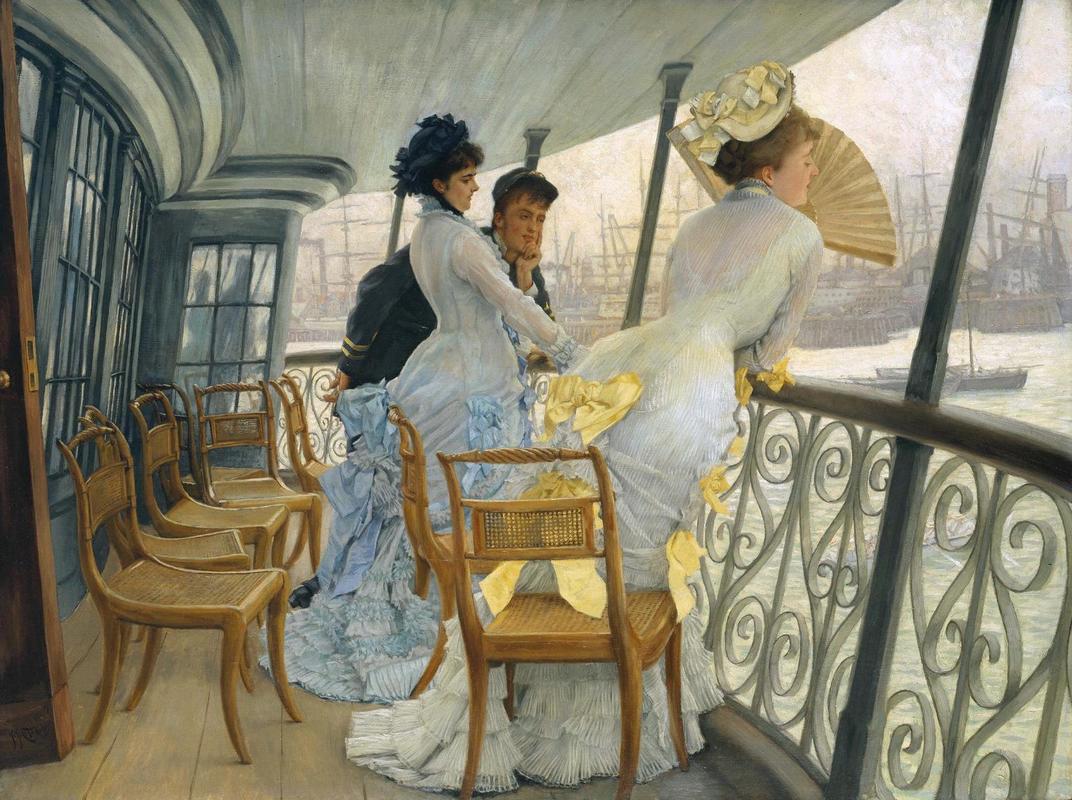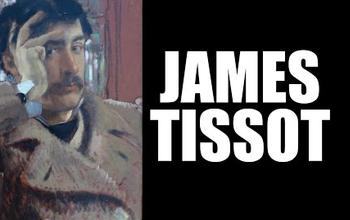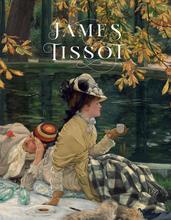More about The Gallery of HMS Calcutta (Portsmouth)
- All
- Info
- Video
- Shop

Contributor
James Tissot was a huge hit in England.
He got to go to all the fancy parties, which is probably how he ended up in the Gallery of the HMS Calcutta. Tissot, a Frenchman, masquerading as an Englishman, was for some strange freakin’ reason seamlessly absorbed into the elite society of England. Tissot fled to London during the Franco-Prussian war in 1870-71. And boy, did he land at a party.
Fashionable is the word most often used to describe the French Painter. Well, he did have an eye for it afterall, growing up with a father who was in the draping business is a sure-shot way of getting that keen eye for detail. However, Tissot’s work has less to do with fashion and more to do with youth. In this painting, you get a glimpse of late-nineteenth-century dating trends. Sure, the women are fashionably dressed. But this painting is more about awkward social situations than who these people are. The chaperone is clearly not having a good time. She wishes she was paid for this sh*t.
The HMS Calcutta docked in Portsmouth in 1876. It was the second ship of the name in the Royal Navy. She wasn’t a stranger to wartime action, having been through the Crimean War and the Second Opium War. In 1865, it was converted to a Gunnery ship and moored at Devonport. Aristocrats and the Nouveau riche would often be invited to these military vessels. The super hot woman on the right giggles into her fan, as the cocky sailor boy tries to sweet-talk her. Again, the chaperone wishes she was somewhere else.
Tissot was called a lot of names, most of them unflattering. Henry James called his work, “hard, vulgar, and banal.” The French painter didn’t care at the time. He was busy investigating societal norms in Victorian England. And man, those rules were excessive. Sure, the sailor definitely looks like bad news, but I’m pretty sure hot girl would have figured that out.
Inevitably, Tissot returned to Paris in 1882 and realized that he agreed with Henry James. All those years he was in England he was rubbing shoulders with the loaded and the beautiful. When he went back to Paris he abandoned his ethnographic study of European society and took up with God, instead.
Sources
- Northup, Lauren. “James Tissot.” Hermitage Collection Connection, n.d. https://hermitagemuseum.wordpress.com/tag/james-tissot/.
- Greenaway, Vicky. “James Tissot, Goodbye, on the Mersey: a Reading of the Transatlantic Journey.” 19: Interdisciplinary Studies in the Long Nineteenth Century0, no. 9 (September 2009). https://doi.org/10.16995/ntn.510.
- “James Tissot: Painting the Victorian Woman, The Hepworth, Wakefield, UK – Review.” Financial Times. Financial Times, March 24, 2013. https://www.ft.com/content/014d3984-92dc-11e2-b3be-00144feabdc0.
- Tate. “'The Gallery of HMS Calcutta (Portsmouth)', James Tissot, C.1876.” Tate, n.d. https://www.tate.org.uk/art/artworks/tissot-the-gallery-of-hms-calcutta….
- “HMS Calcutta (1831).” Wikipedia. Wikimedia Foundation, August 11, 2019. https://en.wikipedia.org/wiki/HMS_Calcutta_(1831).
Featured Content
Here is what Wikipedia says about The Gallery of H.M.S. 'Calcutta' (Portsmouth)



The Gallery of HMS 'Calcutta' (Portsmouth), also known as Officer and Ladies on Board HMS Calcutta, is an 1876 oil painting by the French artist James Tissot. It depicts two ladies in fashionable clothing and a young naval lieutenant, standing on the quarter gallery at the stern of the Royal Navy warship HMS Calcutta. The Tate Gallery in London holds the painting and measures 68.6 by 91.8 centimetres (27.0 in × 36.1 in).
Check out the full Wikipedia article about The Gallery of H.M.S. 'Calcutta' (Portsmouth)















This piece is interesting it shows three people on what appears to be a cruise ship, or maybe someone's personal ship. However in the background we see some ships that appear to be cargo ships, or pirate ships because they have huge masts and sails. The detailing in the end of the dresses is gorgeous. the mix of blues, yellows, and white contrast well with the primarily brown and black background. Even the man is wearing a black suit, the only two people who stand out are the women. They are adorned in what seems to be gorgeous silks that give a simple elegant look of refinement ,but its not constricting it looks very freeing. The woman in gold appears to be ignoring the other two as she has an open fan hiding her face from them. Maybe she was just fanning herself or trying to get rid or the stench from the murky water, either way she is shadowing her face. It makes you wonder what she's avoiding or hiding for the other two.